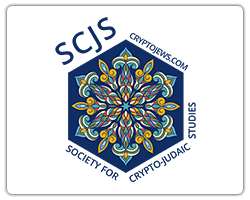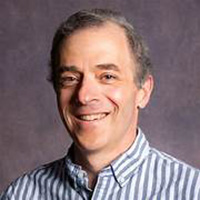Some years ago I was working on a series of paintings rooted in the 

When I began research for the project I had never set foot in a synagogue but when I visited the library of one of the local congregations I knew that I belonged I asked the rabbi’s advice because I did not wish to cause any offense and he suggested I begin by reading Torah 1 did and I was instantly hooked 1 spent hours in the library and started to attend Torah study and services I searched for English sources of Midrash and for translations of folk tales surrounding the Holy Books including Arabic folk tales drawn from the Iloly Koran As I worked on the “Bulto Mezuzah” weaving the Midrash in repousse and carving it in wood I began to realize that both the course of my work and my life had been irrevocably changed
My interest in the subject of the cryptoJews grew as well I made 
Iconic symbolism has long been used as a device to identify the characters in southwestern traditional painting Symbolic elements are used to represent attributes or deeds of each character thus serving as a pictorial narrative 1 invite the viewer who discovers these elements to enquire further by reading the story and finding the Midrash I want the viewer to have an ongoing relationship with the work Whenever I am asked about my art I mean what my art means to me and where my inspiration comes from it forces me to struggle to put into words what I feel so intensely while I am in the process of making art I know what I feel I feel it It is what comes forth when I give myself to the process
Early in my journey of return I came across this saying: “It is said that in the course of each man’s life he should write a Torah” It is an ancient Jewish aspiration to develop the skills and afford the time necessary to accomplish such a daunting mitzvah Art is my language
Midrash notes that at the moment that all of Israel was gathered at the foot of Sinai while Moses stood before HaShem at the very moment that HaShem spoke “I AM” all birds the world over froze in flight the rivers stood still and every living creature listened and heard the words as they reverberated over the face of creation At that moment also every prophet from every people who had ever lived and all of the prophets from future generations yet unborn were called before HaShem and they stood at Moses’ side before the Lord It was then that HaShem said to Moses “See now all of these prophets They speak many tongues so never be surprised to hear them call me by different names” This Midrash inclines me to think that any language calligraphy representation abstraction poetry prose song or any pronounceable or unpronounceable name that can be formed by the human mouth are all accepted No praise is rejected in spite of dogma
There are as many ways to interpret Torah as there are seeds in a pomegranate One can write a Torah as does a sopher (scribe) with calligraphy and words or one may write it after study and reflection with deeds bringing Torah into the world through actions I feel that my art work is my attempt to fulfill the mitzvah using my language Each of my works incorporates elements of the cultural influences I strive to bring forth a genuine expression of those influences in my work as I draw on the reservoir of images and traditions that shape and educate my imagination By using a
parsha or another sacred Jewish text as a springboard the illustration becomes a vehicle to explore visual concepts and express complex philosophic and physical theory The unity that I recognize between such disparate disciplines as quantum physics and Kabbalah the concepts of creation and evolution and the straightforward way they complement one another through Torah and the myriad writings surrounding it have bolstered my palate
I felt confident in my emerging Judaism and I was confident in my identity as a descendent of cryptoJews I had no real evidence but like so many others my maternal line had settled in the Central Rio Grande Valley of New Mexico shortly after the return of the Spanish following the Pueblo Revolt The Pino Baca and Vigil had farmed along the river near Socorro and had ranched the Plains of San Augustine So far as I know no one of my relatives ever considered having a Jewish heritage We had no peculiar practices and there was never anything to indicate that we were anything other than what we presented We were all Catholic My father converted to Catholicism when he married my mother I had been an altar boy I knew though that my family were anusim I cannot prove anything but I feel it and I know it to be the case It makes no matter My understanding and embracing of this heritage has directed my work and my life Despite obstacles I have not looked back or questioned my decision to embrace Torah and Judaism I am the richer for it
In my work I investigate the relationship of form and space I use texture and broad fields of color to push and pull the perception of the positive and negative In the stories of the scriptures are the metaphors to add another dimension to my endeavors Positive and negative is represented through the subject matter as well as through formal technique and application The texture achieved through thick application of paint and repousse is supplemented by Midrash from Talmudic sources and folk tales drawn from millennia of discourse that expresses cultures and experiences from around the world
As I grew in my understanding of the rich tradition of literature woven
The paintings are heavily textured (see insert) and invite the viewer to touch them The deeply embossed surface achieved in the printing process results in a similar effect but absent would be the Hebrew text surrounding each image Much of the nuanced symbolism evident 
The second book from the Tanakh series is titled “Birds of the Sky” a subseries of paintings originally made as a visual narrative of a particular event The book follows David on the day he confronts Goliath and the images arc presented as seen through David’s eyes The illustrations binding and case of each book have been made
I consider the books to be the finished work I regard the paintings as a series of sketches What begins as study and prayer manifests in copper and acrylic on panel I then carve by hand an exact copy of the original painting in reverse so that the resulting print is in the correct orientation After inking the wood surface I lay acid free paper over it and run the print through an intaglio press thereby producing the image I usually run an edition of some thirty or so prints I choose the most consistent images from the edition to begin the next step in the process It was necessary to handcolor the woodcut prints to produce at least ten images that are identical Once all thirteen illustrations were produced I designed the text I used a fire crown Hebrew font that I created to typeset all of the text from I Samuel The Midrash that accompanies the scriptural text was synthesized from a multitude of sources and typeset in Modem Hebrew font to stand apart from the words of the Prophet The edition was printed on archival acid free paper and bound with cotton thread The cover boards are made of archival stock and covered with calf leather The title is crafted in raised IIebrew letters and a copper repousse plate is inlaid on the back cover Copper corner guards finish the binding Each book is nested in a cedar case and rubbed with Tung oil for a lustrous finish The lid is decorated with the title carved in Hebrew The interior is lined with luxurious cotton velvet; a silk satin ribbon is attached to gently lift the book from the case; brass hardware and wool felt detail the construction (see photo on next page)
When I first began to express these concepts in my work I incorporated Hebrew and Midrash with the style and palate that I had so far developed I mixed symbolic iconography and calligraphy with straightforward representation I consider this period representative of my newfound Jewish identity informing and transforming my work
My most recent efforts are the most overtly cryptoJewish so far In one of my more recent series I draw inspiration from an imagined community of cryptoJewish pioneers constructed from a variety of sources concerning the Sephardic Diaspora in the Middle East and the New World as well as histories of the New Mexican frontier
In another series I reintroduce calaveras as a metaphor for times past as the Book of Ester is staged in a MesoAmerican construct rich in Midrash and utilizing archaic scripts and stylistic devices In both series a further dimension exploring the fleeting nature of temporal existence and the concept of Tikkun is expressed in the application of the medium It seems that now my emerging crypto¬self is informing my Judaism but either way it is the work that draws me on
Dan Riis Grife lives and works from his studio in central Texas He exhibits nationally and his books are collected by such institutions as Widener Library at Harvard University and the Library of Congress His work may be viewed at wwwdangrifecom The books are available through wwwvampandtrampcomHe may be contacted at dan@dangrifecom





